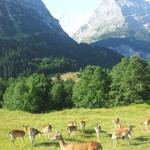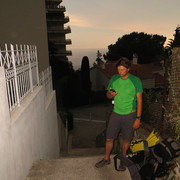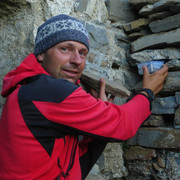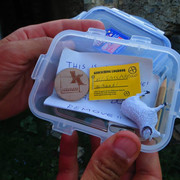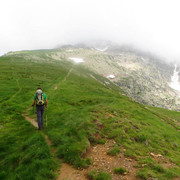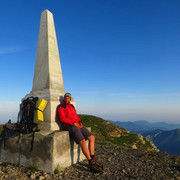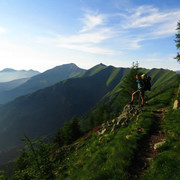“My main aim is to install a sustainable Geocache trail along the last (or first) stretch of the Red Trail encompassing Monaco, Italy and France. The project intends to open up the Via Alpina to a complete new target group. It will also provide an additional incentive for the current target group to undertake one of the long distance hikes. The geocaching communities along the trail should get in contact with each other and form a kind of “Via Alpina task force”, promoting the spirit of the Via Alpina through the extensive geocaching network worldwide. The installed geocaches will convey information about the Via Alpina, its spirit and the sustainable aspects of travelling along the trails.
The framework - What is geocaching?
Geocaching is a real-world outdoor treasure hunt. These treasures, called geocaches, are hidden around the world. The GPS coordinates of the hiding places are uploaded to a website, along with details and clues. Players try to locate these treasures in the nature by using a Smartphone or a GPS device. The thrill is to search for the geocache and not the treasure on its own, since it is only a symbolic assortment of odds and ends.
How can geocaching promote alpine culture, nature, the Alpine Convention and the Via Alpina?
Geocaching has become very popular in recent years, numbering more than 5 Million geocachers worldwide, who are all eager to find treasures in the nature. This game has no age limit and basically everybody can do it. Geocaching is a perfect mean of conveying specific knowledge. In particular the sustainable Geocache trail, consisting out of multiple stages, will be used to raise public awareness on the alpine culture, nature, the Alpine Convention and the Via Alpina. This will be done by riddles on these topics, where the solution will be the key to the next coordinates for the following stage. While puzzling out the solution, the geocachers soak up knowledge and create an increased awareness of nature and aspects concerning the Alpine Convention. This is a kind of informal learning about environmental and societal topics where the educative information is embedded in an exciting activity. For example, the caches can be placed in the vicinity of natural monuments or an important cultural place to raise attention. It is self-explaining that any cache put in place will follow a stringent sustainability maxima in terms of location and used materials – indeed most will probably be purely virtual.
How does geocaching promote physical exercise and non-motorised travel?
There exist two groups of geocachers. One group which is already into outdoor activities and explores new areas by going to nature areas where they will find geocaches. The other group is made out of technology geeks who prefer to fiddle around with technical devices. They are used to drive cars. They are not so keen on outdoor activities but their interest for GPS and its application for geocaching brings them outside. Since the geocaches which are intended to be installed on the Via Alpina are not accessible by car, people are forced to use their feet.
Geocaching is also very popular among families because it gives children a special incentive to hike. Nowadays many people already bring a GPS device along when they are hiking. They can make additional use of their device.
Sustainability
The instalment of the Geocache trail addresses the four pillars of sustainability: social, economical, ecological and cultural sustainability. For instance, the Geocache trail will involve people living in the marginal mountainous area of the Maritime and Ligurian Alps. This project will contribute towards economical empowerment of the locals since it will attract a distinctive type of clientele. The necessity of solving riddles concerning the ecology and the culture of the region fosters the awareness towards these topics. Apart from this, I will live sustainability throughout the project. I will travel to the area by public transport. For the instalment of the Geocache trail I will only use natural materials. A self-developed list of recommendations for sustainable geocaching will guarantee the correct consideration of the environment. Geocaching has obviously the potential for promoting soft tourism since this is not a game where people are coming in masses.
Communication
I will create a description of the Geocache trail on a free geocaching internet platform, where all the information, the clues and the riddles are stated. Any of the 5 Million registered geocachers in the world can get access to this information. Everyone who accomplished the Geocache trail will leave a online log entry where the players share their experiences (this is a compulsory rule induced by the geocaching community). Usually if someone put so much effort and love in a Geocache project, the community will honour it with good publicity and will spread the word very fast which attracts more geocachers. The general public awareness will be fostered through print media articles about the first sustainable Geocache trail on a long distance hiking trail. Special created woodchips coins with the Via Alpina logo on it will be used as special treasure which will increase the notoriety of the Via Alpina additionally.
Apart from the requested video and the internet blog I intend to publish an article in the official geocaching magazine as well as in an outdoor magazine from one of the countries crossed.
Where and when?
The instalment of the geocache trail will take place during a two-week hike starting from Monaco (R161), passing through Italy and ending in Castérino in France (R148). This will be done in the summer 2013.
Participants
I, Andreas Aschaber, will be the group leader and a friend and colleague will come along and help me. I am experienced in installing sustainable Geocache trails and already had a great success with the first sustainable nature Geocache trail in the “alpine park Karwendel” in Tirol. Right now I am doing my PhD in social and economic science in my field of specialisation, sustainability. Apart from that I am working as a nature guide and mountain leader and I am specialized on environment and forest pedagogy. I am a very nature loving, enthusiastic mountaineer who likes anything from hiking, over rock- and ice-climbing up to ski-mountaineering.
Before I start, I will get in contact with the local geocache community along the way and invite them to join us and take part in the instalment of the Geocache trail. I will ask them for support and also to take over the cache guard function (the person who is maintaining the cache) in order to keep the trail a long lasting instalment. This will give me on the one hand the opportunity to promote the spirit of lived sustainability and on the other hand a chance to interact with the local population, understanding their point of view.
I am looking forward to undertaking this outstanding venture!”
Together with his colleague Michaela Rizzolli, Andreas successfully set up the first Via Alpina Geocache Trail during the month of July. A treasure chest now expects the next geocachers in Castérino! At each stage, starting from Monaco, one must look for clues, the correct combination of which leads to successive virtual caches and finally to the final one. And like Andreas and Manuela demonstrate in their video, the Maritime Alps, from sea level to almost 3000m, offer a fantastic setting for this adventure!
All details to set out on the geocache trail can be found on www.opencaching.de/viewcache.php?cacheid=170556!
Contact: Andreas.Aschaber(at)uibk.ac.at
The blog: www.facebook.com/Vialpinageocaching
Links (in German):
www.karwendel.org/de/aktuelles/2012_06_28_Geocachetrail.php
www.geocaching.com

